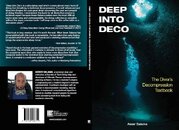Following advice from SB, I ordered a copy of Tom Mount's mixed gas diving encyclopedia, and I've read it with great interest. I understand that this book is quite popular, and Tom gained much respect in the community. In the final chapters, the book introduces the Arterial Bubble Model, apparently in the making for 20+ years, tested during commercial diving operations, and published in tables. The claims in favor of the model sound pretty attractive. A quick search on Google, and then narrowed to scubaboard.com, seems to suggest that this theory has not gained much adoption (the papers also have very few citations). Or has it? What happened to it? Are its assumptions inaccurate, claims still unproven, or has it been superseded with something even better?
You are using an out of date browser. It may not display this or other websites correctly.
You should upgrade or use an alternative browser.
You should upgrade or use an alternative browser.
What happened to the arterial bubble model?
- Thread starter kr2y5
- Start date
Please register or login
Welcome to ScubaBoard, the world's largest scuba diving community. Registration is not required to read the forums, but we encourage you to join. Joining has its benefits and enables you to participate in the discussions.
Benefits of registering include
- Ability to post and comment on topics and discussions.
- A Free photo gallery to share your dive photos with the world.
- You can make this box go away
- Messages
- 2,580
- Reaction score
- 87
You'll be able to read about that in a book titled Deep Into Deco (on the shelves in a couple of months).
Nirvana
Contributor
First of all, as a reference to those who do not have access to the book cited above, there is an article available online by the creators of the model in discussion:
http://gtuem.praesentiert-ihnen.de/tools/literaturdb/project2/pdf/Imbert%20JP.%20-%20EUBS%202004.pdf
I have had the same experience as the OP: read the article on the "Tao of Survival", found the concept interesting and was subsequently surprised at how little additional information I was able to obtain on the subject. I suspect there might be two reasons for the lack of popularity of the model: firstly, it may be proprietary, with the algorithm not made public; secondly, it may not exist in a form available for dive computers, it may only generate pre-planned tables. All this is my speculation, though, as I do not remember reading anything on these two topics.
I too would be curious to know if anyone has had experience using tables generated by the amb-2 model and if they can make a comparison with other models, as to total decompression time and ascent profile.
---------- Post added March 10th, 2014 at 01:24 PM ----------
Could you tell us anything more about the book? Who are its authors, what subjects are discussed? Thanks in advance.
http://gtuem.praesentiert-ihnen.de/tools/literaturdb/project2/pdf/Imbert%20JP.%20-%20EUBS%202004.pdf
I have had the same experience as the OP: read the article on the "Tao of Survival", found the concept interesting and was subsequently surprised at how little additional information I was able to obtain on the subject. I suspect there might be two reasons for the lack of popularity of the model: firstly, it may be proprietary, with the algorithm not made public; secondly, it may not exist in a form available for dive computers, it may only generate pre-planned tables. All this is my speculation, though, as I do not remember reading anything on these two topics.
I too would be curious to know if anyone has had experience using tables generated by the amb-2 model and if they can make a comparison with other models, as to total decompression time and ascent profile.
---------- Post added March 10th, 2014 at 01:24 PM ----------
You'll be able to read about that in a book titled Deep Into Deco (on the shelves in a couple of months).
Could you tell us anything more about the book? Who are its authors, what subjects are discussed? Thanks in advance.
I have never seen this model in any available software or computer, but most French models are not widely adopted in the sport diving community so this isn't unusual. Given that Tom Mount's encyclopedia was last updated in 2009 and that the AB-model is a deep stop algorithm on top of a dissolved gas model, I would suggest that its been superseded by more modern literature. VPM and variants were on the upswing in popularity in 2009. The "deep stops increase risk of DCS" thread has the bulk of cutting edge information, also the 2yo now closed RBW thread on the same topic.
ajduplessis
Contributor
One big never ending cycle. At some point you need to trust your own judgement, either by model recommendation, or your own actual experience. The proof is in how you feel.
- Messages
- 2,580
- Reaction score
- 87
The book launch has been postponed. It should be on the shelves soon.
Out now in 3 forms (print book, eBook and package set)! Find more at Best Publishing Company - Package Set: Deep Into Deco (eBook + print book)
Similar threads
- Replies
- 1
- Views
- 950
- Replies
- 32
- Views
- 4,374
- Replies
- 1
- Views
- 1,289
- Replies
- 8
- Views
- 8,248






